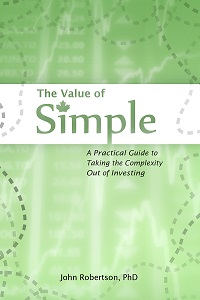Risk and the Gom Jabbar
May 21st, 2015 by PotatoThis is an excerpt from my book The Value of Simple. It has been edited to stand alone as a post.
In the short term the market as a whole (or an index representing it) can go down 50% or more. As you give the market more and more time to work out the short-term fluctuations stocks become less risky1. For some history, there have been quite a number of market crashes where stocks declined. The worst was the 1929 crash that marked the beginning of the Great Depression. Stocks fell some 90% and took about 25 years to recover. But recover they did, and if you would allow yourself to mark that experience down as a one-off, never-to-be-repeated event, then the worst market crashes involve stocks declining by about 50% (including the recent 2008-2009 market crash). Though those events can be quite painful for investors at the time, they do pass and the markets go on to set new highs. If you held on after any given crash the prices recovered within a few years – that’s long enough that in your day-to-day life you’d wonder if the prices would ever recover, but short enough that it would happen soon enough to matter.
When deciding whether to invest in equities, and how much you can allocate to them, on top of your time horizon is the matter of risk tolerance: your ability to receive a statement from your financial institution showing that the value of your investments had been cut in half, and to not panic or lose sleep at night – or worse yet, log in to your account and sell all of your holdings out of fear or disgust. If you’re the type of person who would panic in the midst of prices falling, seeing everyone else selling and decide that you would join the pack, you would take a “paper loss†that might recover (and given the historical record, would in all likelihood do so) and transform it into a permanent loss. Better in that case to stick to safer investments right from the beginning. Better still though to separate emotions from your investing, and keep a coldly rational long-term perspective.
You need to sort out your risk tolerance in advance: the midst of a market panic and sell-off is not the time to discover your risk tolerance isn’t what you thought and to try to change your plan when it is most expensive to do so. Indeed, that is the time to pull out your planning binder and remind yourself of the long-term plan and what you decided you should do in a market downturn when you were in a calm and rational state.
Unfortunately, there isn’t much of a substitute for that real-world experience of living through a market crash. In Frank Herbert’s science fiction masterpiece Dune, a young Paul Atreides had to endure a test of his humanity called the Gom Jabbar, wherein a magical box simulated the experience of excruciating pain (but left no lasting tissue damage); he had to display the ability to withstand short-term pain and resist his animal instincts in the interest of his long-term future by holding his hand in the box and enduring it by sheer force of will. There are times I wish a similar test existed for investors to accurately gauge their risk tolerance before a market crash, a way to harmlessly experience the pain and roller-coaster of emotions that accompany living through a market crash. Instead you will just have to make the most honest assessment of yourself that you can, and attempt to prepare yourself for what may come — bearing in mind that years-long market crashes and corrections that look like blips on long-term stock charts really consist of day upon day of uncertainty and fear-mongering news reports.
When considering your ability to take risk remember that risk tolerance can also include things like your job or life situation: if you’re in a field that is very boom-and-bust, then you may not want to invest as much in stocks which can also be boom-and-bust-like, because you may find yourself unemployed at the same time that the investments you’ll need to live off of are selling for less. If you’re younger, you have more time to wait for a market recovery or adjust your savings plan than if you are close to retirement. The young can also be more certain of their continued ability to work and save, whereas when you get older your chance of having your investment timeline cut short by a chronic disease increase.
Risk tolerance also touches on your financial ability to suffer losses without destroying your life. If you have a large financial cushion or flexibility in your financial needs you may have a higher risk tolerance. For example, if you were planning on buying a car in four years that would generally be considered too short a time-frame to risk putting the money you have saved up in equities. Yet if you had the flexibility to buy a cheaper car if you did suffer a loss, or to delay your purchase by a few years, it might not be such a black-and-white situation as the timeline alone suggests.
Though I have attempted to put you into the proper mindset with all the warnings of the riskiness of stocks, the simple fact is that investing in stocks is the only easily accessible way to get such high expected returns, with so little effort and expertise required. The warnings are to prepare you for the inevitable rough ride in investing, and not to scare you off of investing entirely. Indeed, including at least some exposure to stocks is critical to reducing your overall risk of running out of money in retirement.
Keep in mind that the volatility of the stock market is very attention-grabbing; market crashes are stressful times and stories of hardship and loss can get passed down through the generations. However, the hidden risks of paying too much in fees or starting too late can be just as costly over the long run – and you cannot recover from those by waiting.
And though I would caution against trying to “time the marketâ€, better returns come from buying when the market is low (remember the aphorism “buy low, sell highâ€). That will bring us to rebalancing later [in the book], but it’s important to remember that when you’re in the phase of your life when you’re saving money (i.e. when you’re young), you want to be buying stocks when they’re cheaper. So if (when) a market crash comes along, that’s not the time to wring your hands, lament your losses, and consider selling and getting out of the crazy world of investing. Instead it’s the time to cheer the bargains, to buy more, to take advantage of the temporary insanity of the traders to set yourself up for later. Market crashes, as much as they are feared and vilified in the media, usually end up being good for a young investor, and conversely, people do not make money by “waiting for things to settle down.†As long as you have faith that in the long term businesses will continue to be profitable and grow, then eventually your diversified investments should perform for you.
Understanding your risk tolerance in advance is critical for investing success and your ability to stick to your plan through future volatility. Risk tolerance has many components, including details of your situation as well as your psychology.
In the short term, equities can have large losses and high volatility. But history shows that patient investors have been well rewarded over the long term.
1. If you have a definition of risk that is not simply volatility.


 Questrade: use QPass 356624159378948
Questrade: use QPass 356624159378948 Passiv is a tool that can connect to your Questrade account and make it easier to track and rebalance your portfolio, including the ability to make one-click trades.
Passiv is a tool that can connect to your Questrade account and make it easier to track and rebalance your portfolio, including the ability to make one-click trades.